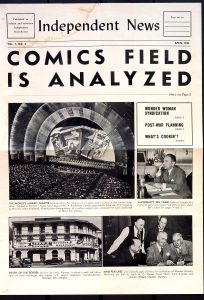Morgan E. Aronson has recently departed the Smithsonian Libraries but was previously the library technician at the Dibner Library of the History of Science and Technology. The role of the more »
Author: Morgan E. Aronson
Music is a funny thing. It may spring from the heart, the soul, or the mind, from a communal cultural or religious experience, from an intensely personal place, a popular more »
Obsession is a tricky word. Any bibliophile can sense it coming, when they read a new dealer description or see that perfect binding. We’re using the word in our upcoming more »

Amid the manuscripts, incunabula and early modern texts at the Dibner Library of the History of Science and Technology are two bright blue binders that don’t seem to quite fit, in every sense of the word. Too big for the shelf and too 20th century for the Dibner, don’t judge these books by their covers! In honor of National Comic Book Day we would like to highlight two of the Dibner’s most popular holdings—William Moulton Marston’s letters and scripts for the original Wonder Woman comic book series.
“George Sarton, a founder of the history of science as an academic discipline, argued that scholars should pay close attention to portraits. These images, he said, can give you ‘the whole man at once.’ With a ‘great portrait,’ Sarton believed, ‘you are given immediately some fundamental knowledge of him, which even the longest descriptions and discussions would fail to evoke.’ Sarton’s ideas led Bern Dibner to purchase portrait prints of men and women of science and technology. Many of these are now in the Smithsonian’s Dibner Library of the History of Science and Technology.” – Deborah Jean Warner, Curator, Physical Sciences Collection
A picture may tell 1000 words, but another 500 for context can add depth to the image. Follow this blog series to discover the people behind the portraits available online in the Scientific Identity collection.
“George Sarton, a founder of the history of science as an academic discipline, argued that scholars should pay close attention to portraits. These images, he said, can give you ‘the whole man at once.’ With a ‘great portrait,’ Sarton believed, ‘you are given immediately some fundamental knowledge of him, which even the longest descriptions and discussions would fail to evoke.’ Sarton’s ideas led Bern Dibner to purchase portrait prints of men and women of science and technology. Many of these are now in the Smithsonian’s Dibner Library of the History of Science and Technology.” – Deborah Jean Warner, Curator, Physical Sciences Collection
A picture may tell 1000 words, but another 500 for context can add depth to the image. Although this particular portrait is not held in the Dibner Library, this fascinating woman of science is well-worth exploring through her visual depiction. Follow this blog series to discover the people behind the portraits.
“George Sarton, a founder of the history of science as an academic discipline, argued that scholars should pay close attention to portraits. These images, he said, can give you ‘the whole man at once.’ With a ‘great portrait,’ Sarton believed, ‘you are given immediately some fundamental knowledge of him, which even the longest descriptions and discussions would fail to evoke.’ Sarton’s ideas led Bern Dibner to purchase portrait prints of men and women of science and technology. Many of these are now in the Smithsonian’s Dibner Library of the History of Science and Technology.”
– Deborah Jean Warner, Curator, Physical Sciences Collection






